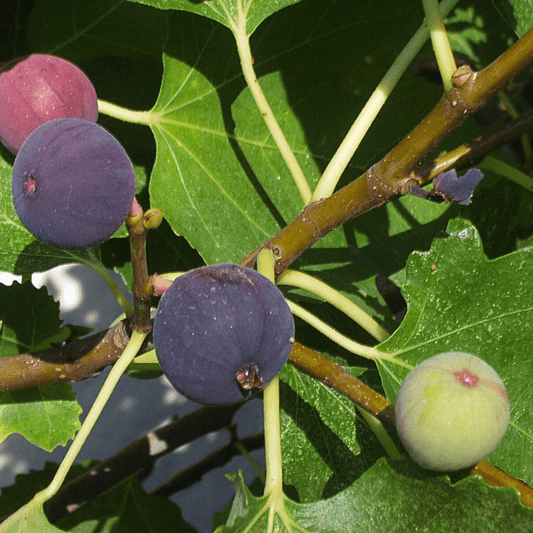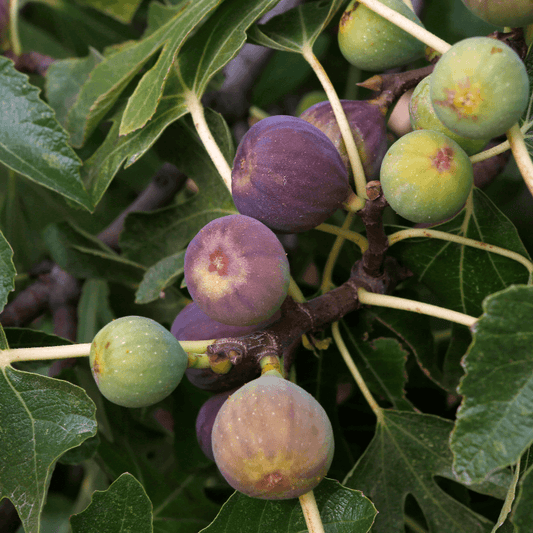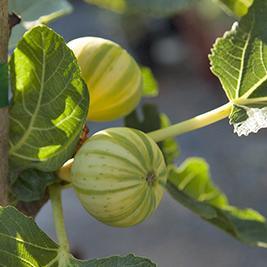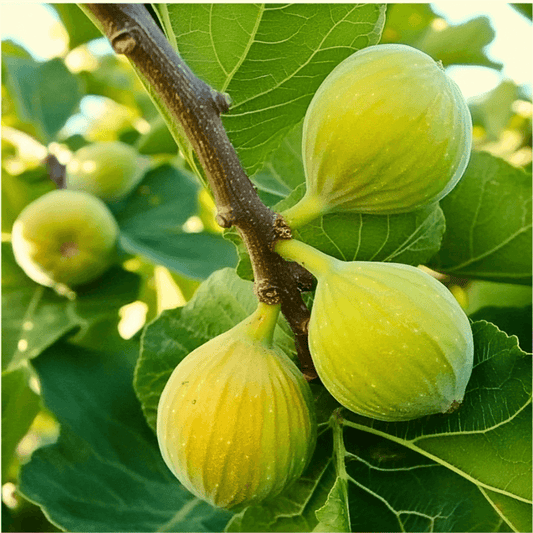Collection: Figs are a Great Addition to Your Orchard
Embarking on the journey of cultivating an organic fig tree opens the door to a delightful world of sweet, fresh figs—whether eaten fresh or made into dried figs. Whether you're an experienced gardener or a novice enthusiast, understanding the intricacies of growing a fig tree is crucial for a thriving harvest. When browsing organic fig trees choosing the right variety for your garden ensures the best results. Keep in mind the role of the fig wasp in pollination, which is essential for certain fig varieties. Caring for fig trees also involves monitoring their distinctive fig leaves, vital for photosynthesis and overall plant health. Whether you're harvesting figs in summer or fall, or considering how your figs put into culinary use, understanding the needs of your fig tree from the Moraceae family will ensure a fruitful, delicious yield.
Choosing the Right Fig Variety:
-
The Common Fig Tree (Ficus carica): This variety is widely cultivated for its edible fruit and adaptability to various climates.
-
Breba Crop: Some fig trees produce a breba crop, which refers to the first crop of figs borne on last season's growth. This early yield can be a delicious bonus.
Site Selection and Planting:
-
Fig trees are versatile and can be grown in various climates, but they thrive in areas with warm, long growing seasons.
-
Full Sun: Fig trees love sunlight. Choose a location that receives at least 6-8 hours of direct sunlight daily for optimal growth.
-
Well-Drained Soil: Figs prefer well-drained soil. Sandy loam or loamy soil types are ideal. Good drainage helps prevent waterlogged roots.
-
Container Gardening: If space is limited, fig trees can be grown in containers. This allows for flexibility in moving them to suitable locations.
Watering and Maintenance:
-
Consistent Moisture: Figs require consistent moisture, especially during dry periods. Water deeply but allow the soil to dry out between watering to prevent root issues.
-
Mulching: Apply a layer of organic mulch around the base of the tree to retain soil moisture and suppress weeds.
-
Feeding: Fertilize fig trees with a balanced, organic fertilizer in early spring. Avoid excessive nitrogen, which can lead to excessive vegetative growth.
Pollination and Fruit Development:
-
Self-Pollinating: The common fig tree is typically self-pollinating, meaning it doesn't require cross-pollination with another tree to set fruit.
-
Breba and Main Crop: Figs often produce two crops: the breba crop in spring on last year's growth and the main crop in summer on new growth.
Pruning and Size Control:
-
Size Variation: Fig trees can be grown in various sizes, from compact shrubs to large trees reaching up to 30 feet tall.
-
Pruning for Shape: Prune fig trees to shape and remove dead or crowded branches. This encourages better air circulation and sunlight penetration.
Winter Care:
-
Cold Hardiness: Figs are hardy in many regions, but protection may be needed in colder climates. Wrapping the tree or covering it with frost blankets can provide winter protection.
-
Mulching Roots: Apply a thick layer of mulch around the base of the tree to insulate the roots from winter cold.
Harvesting and Enjoying Figs:
-
Ripe Characteristics: Figs are ready for harvest when they are slightly soft to the touch, have a rich color, and easily detach from the tree.
-
Versatile Use: Enjoy figs fresh as a snack or incorporate them into salads, desserts, or jams. They can also be dried for longer shelf life.
Common Challenges and Solutions:
-
Bird Protection: Birds can be attracted to ripe figs. Use bird netting or other protective measures to prevent birds from consuming your harvest.
-
Root Knot Nematodes: Planting figs in well-drained soil can help reduce the risk of root knot nematode infestations. Crop rotation is also beneficial.
Growing Fig Trees with Success
Growing fig trees is a rewarding experience that combines the joy of cultivation with the pleasure of harvesting delicious fruits. Whether you have a sprawling garden or limited space for container gardening, selecting the right variety and providing optimal care are essential for successful fig tree growth. Embrace the art of fig cultivation, and you'll be rewarded with a bountiful harvest and the satisfaction of nurturing these delightful fruit-bearing trees in your own outdoor space.
Learn about the growing season and how to care for fig trees in our Growing Guide as well as more information on potted trees.
 Sold out
Sold out Sold out
Sold out








